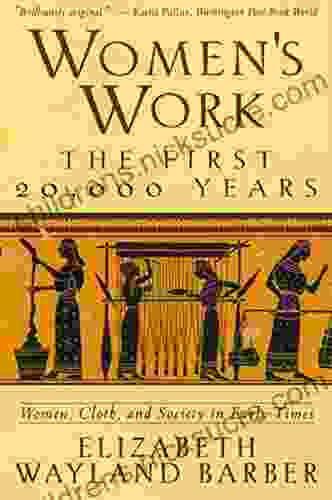The First 20,000 Years: Women, Cloth, and Society in Early Times

4.7 out of 5
| Language | : | English |
| File size | : | 9877 KB |
| Text-to-Speech | : | Enabled |
| Screen Reader | : | Supported |
| Enhanced typesetting | : | Enabled |
| X-Ray | : | Enabled |
| Word Wise | : | Enabled |
| Print length | : | 338 pages |
Clothing is a fundamental aspect of human society. It serves a variety of purposes, from protecting the body from the elements to expressing one's identity. Clothing also plays an important role in social interactions, as it can be used to communicate status, wealth, and power.
The history of clothing is long and complex, but women have always played a central role in its development. From the earliest days of human history, women have been responsible for making and maintaining clothing for themselves, their families, and their communities.
The materials used to make clothing have varied over time and across cultures. In early times, people used natural materials such as animal skins, plant fibers, and wool. As civilizations developed, new materials such as cotton, silk, and linen became available.
The styles of clothing have also changed over time. In early times, clothing was often simple and functional. As societies became more complex, clothing became more elaborate and decorative.
The role of women in society has also changed over time. In early times, women were often responsible for all aspects of clothing production, from gathering the materials to making and maintaining the garments. As societies became more complex, women's roles in clothing production became more specialized.
In some cultures, women were responsible for making all of the clothing for their families. In other cultures, women were responsible for making certain types of clothing, such as clothing for women and children. In still other cultures, women were responsible for making all of the clothing, but men were responsible for decorating it.
The relationship between women and clothing is complex and multifaceted. Clothing can be a source of power and status for women, but it can also be a source of oppression and control.
In some cultures, women are expected to dress modestly and cover their bodies. In other cultures, women are free to dress as they please. The way that women dress can send a message about their social status, their sexual availability, and their religious beliefs.
Clothing can also be a way for women to express their creativity and individuality. In many cultures, women have developed their own unique styles of clothing. These styles can reflect the woman's personality, her culture, and her social status.
The history of women's clothing is a long and fascinating one. It is a story of creativity, innovation, and social change. It is also a story of oppression and control. As we learn more about the history of women's clothing, we can better understand the role that women have played in society throughout history.
The Stone Age
The Stone Age is the earliest period of human history, lasting from about 2.6 million years ago to about 3,000 years ago. During this time, humans used stone tools and weapons to hunt, gather, and defend themselves.
Clothing was essential for survival in the Stone Age. It protected people from the elements and helped to keep them warm. The materials used to make clothing in the Stone Age included animal skins, plant fibers, and wool.
Animal skins were the most common material used to make clothing in the Stone Age. Animal skins were durable and provided good protection from the elements. However, animal skins were also heavy and uncomfortable to wear.
Plant fibers were another common material used to make clothing in the Stone Age. Plant fibers were lighter and more comfortable to wear than animal skins. However, plant fibers were not as durable as animal skins and they could not be used to make as many different types of clothing.
Wool was the third most common material used to make clothing in the Stone Age. Wool was warm and comfortable to wear. However, wool was also expensive and it was not available in all areas.
The styles of clothing worn in the Stone Age were simple and functional. Clothing was typically made from a single piece of material that was wrapped around the body. Clothing was often decorated with beads, shells, and other natural materials.
Women were responsible for making and maintaining clothing in the Stone Age. Women gathered the materials, prepared the materials, and made the clothing. Women also decorated the clothing with beads, shells, and other natural materials.
The Bronze Age
The Bronze Age is the second period of human history, lasting from about 3,000 years ago to about 1,200 years ago. During this time, humans began to use bronze tools and weapons.
The use of bronze tools and weapons led to a number of changes in society. One of these changes was the development of new materials for making clothing.
Cotton, silk, and linen were new materials that became available during the Bronze Age. These materials were lighter and more comfortable to wear than animal skins and plant fibers. Cotton, silk, and linen were also more durable than animal skins and plant fibers, and they could be used to make a wider variety of clothing.
The styles of clothing worn in the Bronze Age were more elaborate than the styles of clothing worn in the Stone Age. Clothing was often made from multiple pieces of material that were sewn together. Clothing was also often decorated with embroidery, beads, and other embellishments.
Women were still responsible for making and maintaining clothing in the Bronze Age. However, women's roles in clothing production became more specialized. Some women were responsible for spinning thread, while others were responsible for weaving cloth. Still other women were responsible for sewing clothing.
The Bronze Age was a time of great social change. The development of new materials for making clothing led to the development of new styles of clothing. Women's roles in clothing production also became more specialized. These changes had a significant impact on the way that women lived and worked.
The history of women's clothing is a long and fascinating one. It is a story of creativity, innovation, and social change. It is also a story of oppression and control. As we learn more about the history of women's clothing, we can better understand the role that women have played in society throughout history.
4.7 out of 5
| Language | : | English |
| File size | : | 9877 KB |
| Text-to-Speech | : | Enabled |
| Screen Reader | : | Supported |
| Enhanced typesetting | : | Enabled |
| X-Ray | : | Enabled |
| Word Wise | : | Enabled |
| Print length | : | 338 pages |
Do you want to contribute by writing guest posts on this blog?
Please contact us and send us a resume of previous articles that you have written.
 Fiction
Fiction Non Fiction
Non Fiction Romance
Romance Mystery
Mystery Thriller
Thriller SciFi
SciFi Fantasy
Fantasy Horror
Horror Biography
Biography Selfhelp
Selfhelp Business
Business History
History Classics
Classics Poetry
Poetry Childrens
Childrens Young Adult
Young Adult Educational
Educational Cooking
Cooking Travel
Travel Lifestyle
Lifestyle Spirituality
Spirituality Health
Health Fitness
Fitness Technology
Technology Science
Science Arts
Arts Crafts
Crafts DIY
DIY Gardening
Gardening Petcare
Petcare Carl J Pratt
Carl J Pratt Steph Jagger
Steph Jagger Don Larsen
Don Larsen Stephane Cazeault
Stephane Cazeault Dick Crouser
Dick Crouser Illustrated Edition Kindle Edition
Illustrated Edition Kindle Edition Laurie Varga
Laurie Varga Benedict Go
Benedict Go Quinn Loftis
Quinn Loftis Brian Smith
Brian Smith J Budziszewski
J Budziszewski Lori Morrison
Lori Morrison Rachel Hartman
Rachel Hartman Sean Vigue
Sean Vigue John Krige
John Krige Jeremy Griffith
Jeremy Griffith Jena Pincott
Jena Pincott Dale Peterson
Dale Peterson Judy Goodspeed
Judy Goodspeed Bob Stegner
Bob Stegner Larry Greene
Larry Greene Oliver Horovitz
Oliver Horovitz Phil G Tang
Phil G Tang Michael Yessis
Michael Yessis T Chris Riley Tillman
T Chris Riley Tillman Ann Cameron
Ann Cameron Stan Lee
Stan Lee Paul Fowler
Paul Fowler Kristen S Kurland
Kristen S Kurland Ann Cook
Ann Cook Rebecca M Warner
Rebecca M Warner Tracy Salcedo
Tracy Salcedo Bruce Gregor Hodge
Bruce Gregor Hodge Eliot Cowan
Eliot Cowan Je Earl
Je Earl Lara Maiklem
Lara Maiklem Paul Eng
Paul Eng Terry Tempest Williams
Terry Tempest Williams Damo Mitchell
Damo Mitchell William J Ray
William J Ray Kevin Robbins
Kevin Robbins Richard J Davidson
Richard J Davidson Lisa Charlebois
Lisa Charlebois Tyler Feder
Tyler Feder Sean Parker Dennison
Sean Parker Dennison Stephanie Garber
Stephanie Garber Mark Bertin Md
Mark Bertin Md Darlene D Pedersen
Darlene D Pedersen J L Heilbron
J L Heilbron Nouaoui Khedidja
Nouaoui Khedidja Norman Hall
Norman Hall Roasted Rat
Roasted Rat Edward O Thorp
Edward O Thorp Jean Molesky Poz
Jean Molesky Poz One Exam Prep
One Exam Prep Daxton Wilde
Daxton Wilde Caleb Lee
Caleb Lee James Freeman
James Freeman Janet Patkowa
Janet Patkowa Joy Bauer
Joy Bauer F C Yee
F C Yee Brook Waters
Brook Waters Robert Jervis
Robert Jervis Kumiko Makihara
Kumiko Makihara Sara Wolf
Sara Wolf Felicity Aston
Felicity Aston Joshua Straub
Joshua Straub Daniel Harman
Daniel Harman Tabatha Yeatts
Tabatha Yeatts Chris Matakas
Chris Matakas Joe Shuber
Joe Shuber Elizabeth G Harper
Elizabeth G Harper Ann Marie Brown
Ann Marie Brown Elwyn Hayes
Elwyn Hayes Intisar Khanani
Intisar Khanani Angie Papple Johnston
Angie Papple Johnston Myron Mixon
Myron Mixon Flor M Salvador
Flor M Salvador Graham Allcott
Graham Allcott Kit Deslauriers
Kit Deslauriers Persia Woolley
Persia Woolley Wade Bourne
Wade Bourne Sharan B Merriam
Sharan B Merriam Cgp Books
Cgp Books Oswald Rivera
Oswald Rivera Val Waldeck
Val Waldeck Julie Gianelloni Connor
Julie Gianelloni Connor Cathy Glass
Cathy Glass Sandra Steingraber
Sandra Steingraber Rebecca Rolland
Rebecca Rolland Richard Weaver
Richard Weaver Hugh Harris
Hugh Harris Judith A Muschla
Judith A Muschla Namit Arora
Namit Arora Steven Cowie
Steven Cowie Tabatha Chansard Phd
Tabatha Chansard Phd David J Wallin
David J Wallin Ann Bausum
Ann Bausum Josh Kaufman
Josh Kaufman Sherman Dickinson
Sherman Dickinson Stanley Vestal
Stanley Vestal Eugene Hecht
Eugene Hecht Isla Gordon
Isla Gordon Grant Mcomie
Grant Mcomie Elizabeth Wayland Barber
Elizabeth Wayland Barber Kenneth Wilgus Phd
Kenneth Wilgus Phd Janet Renner
Janet Renner Daniel Paolicchi
Daniel Paolicchi David E Maranz
David E Maranz Natale Barca
Natale Barca Peter Julius Sloan
Peter Julius Sloan Peter Lee
Peter Lee Robert Edelman
Robert Edelman Eric B Taylor
Eric B Taylor Sarah Pink
Sarah Pink Alex Bonham
Alex Bonham Dan Hicks
Dan Hicks Tanya Holland
Tanya Holland Ben Magid
Ben Magid Tami Oldham Ashcraft
Tami Oldham Ashcraft Martin L Kutscher
Martin L Kutscher Terry Leiden
Terry Leiden Judy Cannato
Judy Cannato Ray Dozier
Ray Dozier Peter Liljedahl
Peter Liljedahl Duncan Van Dusen
Duncan Van Dusen Tyler Ninja Blevins
Tyler Ninja Blevins Sharon Cameron
Sharon Cameron Antonia Malchik
Antonia Malchik Darren Kirby
Darren Kirby Tracy Wolff
Tracy Wolff Michael Harner
Michael Harner D J Taylor
D J Taylor Emily Teeter
Emily Teeter Ariel Dalfen
Ariel Dalfen Simon Boulter
Simon Boulter Cynthia Miller Idriss
Cynthia Miller Idriss Terry Hill
Terry Hill Wendy Moore
Wendy Moore Brianna Madia
Brianna Madia Enrique Desmond Arias
Enrique Desmond Arias Tri Thong Dang
Tri Thong Dang Phoenix Nature
Phoenix Nature Jack O Connor
Jack O Connor John Heart
John Heart Ann Leary
Ann Leary Brian Platzer
Brian Platzer Lindsey Fitzharris
Lindsey Fitzharris Ed Robinson
Ed Robinson Gregory J Stewart
Gregory J Stewart Angie Thomas
Angie Thomas Joe Fox
Joe Fox Peter Feinman
Peter Feinman Michael Easter
Michael Easter John Brockman
John Brockman Jada Fisher
Jada Fisher Julie Knutson
Julie Knutson James Campbell
James Campbell Paul Vachon
Paul Vachon Warren Berger
Warren Berger Bookrags Com
Bookrags Com Gary Sutherland
Gary Sutherland Little Mat
Little Mat Dean Karnazes
Dean Karnazes Clinton Bailey
Clinton Bailey Yuri Kitayama
Yuri Kitayama Aditya Chatterjee
Aditya Chatterjee Richard Paul Evans
Richard Paul Evans Kevin Callan
Kevin Callan Megan Hallett
Megan Hallett Larry Mueller
Larry Mueller Neil Smith
Neil Smith Nick Schade
Nick Schade Chris Townsend
Chris Townsend Guy Deutscher
Guy Deutscher Willie Mosconi
Willie Mosconi Ron Rhodes
Ron Rhodes Marley Hall
Marley Hall Jason Aaron
Jason Aaron Christina Mcghee
Christina Mcghee Marc Roche
Marc Roche Tina Payne Bryson
Tina Payne Bryson Govert Schilling
Govert Schilling Ann Bingham
Ann Bingham Victoria Clarke
Victoria Clarke 2nd Edition Kindle Edition
2nd Edition Kindle Edition Joshua Glenn
Joshua Glenn Douglas Axe
Douglas Axe Nicholaos Kehagias
Nicholaos Kehagias Imre Lakatos
Imre Lakatos Jim Grimsley
Jim Grimsley Iri Cermak
Iri Cermak Reed Mangels
Reed Mangels Eric Alpenfels
Eric Alpenfels Emile Durkheim
Emile Durkheim Katherine Nichols
Katherine Nichols Jim Burris
Jim Burris Nicholas Wade
Nicholas Wade Susanne Elizabeth Freidberg
Susanne Elizabeth Freidberg Michael Deshotels
Michael Deshotels Nick Clausen
Nick Clausen Ray Bergman
Ray Bergman Joshua Wright
Joshua Wright Fred Heath
Fred Heath Michael S A Graziano
Michael S A Graziano Robert G Bugge
Robert G Bugge John Romer
John Romer J M Thompson
J M Thompson Shannon Greenland
Shannon Greenland Beth Berry
Beth Berry Evelyn Monahan
Evelyn Monahan Ronald M Holmes
Ronald M Holmes Paul Stewart
Paul Stewart Kaylind Olson
Kaylind Olson Steven Dillon
Steven Dillon Gary Robert Muschla
Gary Robert Muschla Iain Mccalman
Iain Mccalman Barry Correia
Barry Correia Angelo Tropea
Angelo Tropea Stephen G Post
Stephen G Post Johnegreek
Johnegreek David J Lieberman
David J Lieberman Patricia Ann Lynch
Patricia Ann Lynch Brian Burke
Brian Burke Buster Holmes
Buster Holmes L R Shorter
L R Shorter Vivienne Crow
Vivienne Crow Shirley Maclaine
Shirley Maclaine Jazmine Mccoy
Jazmine Mccoy Frederick Lewis Allen
Frederick Lewis Allen Katherine Keith
Katherine Keith Sherrie Eldridge
Sherrie Eldridge Art Clepper
Art Clepper John Feinstein
John Feinstein Peter Galison
Peter Galison Ichigo Takano
Ichigo Takano Frank Falcinelli
Frank Falcinelli Gavin Atkin
Gavin Atkin Susan Zimmermann
Susan Zimmermann Eric Wargo
Eric Wargo Martina Sprague
Martina Sprague R H Charles
R H Charles Presh Talwalkar
Presh Talwalkar Poul Anderson
Poul Anderson Deborah Reber
Deborah Reber Mia Collins Parker
Mia Collins Parker Tony Butt
Tony Butt Bill Bishop
Bill Bishop Kalman Samuels
Kalman Samuels Rc Blakes Jr
Rc Blakes Jr Nims Purja
Nims Purja Thomas Thompson
Thomas Thompson Sarah J Tracy
Sarah J Tracy Christina Tosch
Christina Tosch Wendy Mogel
Wendy Mogel Helen Yang
Helen Yang Miles Cameron
Miles Cameron Donovan Buck
Donovan Buck Julius Evola
Julius Evola Magnus D Jango
Magnus D Jango Robison Wells
Robison Wells Henry A Giroux
Henry A Giroux Lindsey Hutchinson
Lindsey Hutchinson Brian Hayden
Brian Hayden David Roche
David Roche Angie Stanton
Angie Stanton Julie Cwikla Phd
Julie Cwikla Phd Mark Wilson
Mark Wilson William Lee
William Lee Dr Tracy Sanders
Dr Tracy Sanders Joanna Nylund
Joanna Nylund Julian Guthrie
Julian Guthrie Max Kuhn
Max Kuhn Anita Biase
Anita Biase Waysun Liao
Waysun Liao Sharlene Healy
Sharlene Healy Jade Mckenzie Stone
Jade Mckenzie Stone Scott Keyes
Scott Keyes Becky Choi
Becky Choi Frank Mastini
Frank Mastini Rob Kelley
Rob Kelley Gina Atencio Maclean Psyd
Gina Atencio Maclean Psyd Erling Kagge
Erling Kagge Chris Dombrowski
Chris Dombrowski Henny Bogan
Henny Bogan David Robert Grimes
David Robert Grimes John J Kaag
John J Kaag David M Gitlitz
David M Gitlitz Imogen Barnacle
Imogen Barnacle John Frohnmayer
John Frohnmayer Lisa Gardner
Lisa Gardner James Nickells
James Nickells Shannon Philpott Sanders
Shannon Philpott Sanders Discover Press
Discover Press Jane Goodall
Jane Goodall Mary Helen Bowers
Mary Helen Bowers Jody Vasquez
Jody Vasquez Ray Walker
Ray Walker Helen Czerski
Helen Czerski Chad Wesley Smith
Chad Wesley Smith Sarah Albee
Sarah Albee Nikki Goth Itoi
Nikki Goth Itoi Karl Deisseroth
Karl Deisseroth Jennifer Dugan
Jennifer Dugan Richard Rorty
Richard Rorty Ania G
Ania G Robert A Sadowski
Robert A Sadowski Laurie R King
Laurie R King Peter Croker
Peter Croker Tommy Shea
Tommy Shea Jerry C Whitaker
Jerry C Whitaker Stu Ingraham
Stu Ingraham Jessica Redland
Jessica Redland Baby Professor
Baby Professor Rick Clark
Rick Clark Alana Ash
Alana Ash Peter Wacht
Peter Wacht Ryan Boudreaux
Ryan Boudreaux Laura M Ahearn
Laura M Ahearn Ann Israel
Ann Israel Lisa Hoehn
Lisa Hoehn Sankofa Ra
Sankofa Ra L A Cotton
L A Cotton Marck Vaisman
Marck Vaisman Chuck Robbins
Chuck Robbins Tim Kimmel
Tim Kimmel Beth Cavenaugh
Beth Cavenaugh Robin Esrock
Robin Esrock David Deming
David Deming Shonda Schilling
Shonda Schilling Bill Fowler
Bill Fowler Dr Mike Dilkes
Dr Mike Dilkes Tim Leffel
Tim Leffel Scott Cunningham
Scott Cunningham Kamran Nazeer
Kamran Nazeer Thomas Lewis
Thomas Lewis Dickie Bird
Dickie Bird Russ Mitchell
Russ Mitchell Mari Silva
Mari Silva Bruce Ackerberg
Bruce Ackerberg Sadie Word
Sadie Word Sharon N Covington
Sharon N Covington Pete Earley
Pete Earley Julie Watson
Julie Watson Marc Weissbluth M D
Marc Weissbluth M D Ryan Tandler
Ryan Tandler Jeff A Johnson
Jeff A Johnson Karen Lynch
Karen Lynch Steve Economides
Steve Economides Justin Mcelroy
Justin Mcelroy Jason Rosenhouse
Jason Rosenhouse Robin Barrett
Robin Barrett Joan Didion
Joan Didion Bob Greene
Bob Greene Simon Winchester
Simon Winchester William H Parker
William H Parker Behrouz Moemeni
Behrouz Moemeni Weston Ochse
Weston Ochse Ava Richardson
Ava Richardson Mark Mayfield
Mark Mayfield Bruce Feiler
Bruce Feiler Gail Carriger
Gail Carriger Johnny Molloy
Johnny Molloy Don Jose Ruiz
Don Jose Ruiz Sean Deveney
Sean Deveney Scholastic
Scholastic Ann Douglas
Ann Douglas Kate Bowler
Kate Bowler Brent E Turvey
Brent E Turvey Tom Dokken
Tom Dokken Kim Loraine
Kim Loraine Anthony Castrovince
Anthony Castrovince Philip P Massaro
Philip P Massaro Beth A Grosshans
Beth A Grosshans Rae Brewer
Rae Brewer Paul Hough
Paul Hough Vicki Lansky
Vicki Lansky Kristin Knight Pace
Kristin Knight Pace Hippocrates
Hippocrates Jack El Hai
Jack El Hai Ann Chamberlin
Ann Chamberlin Anja Beran
Anja Beran Emma Hansen
Emma Hansen Shane Frederick
Shane Frederick Anita Cortez
Anita Cortez Ann Mariah Cook
Ann Mariah Cook Anita Knight Kuhnley
Anita Knight Kuhnley Doug Cook
Doug Cook Michele Caputo
Michele Caputo Emma Anne Bellamy
Emma Anne Bellamy Michael Edelson
Michael Edelson Molly Harper
Molly Harper Emiko Jean
Emiko Jean Dorothy Roberts
Dorothy Roberts Miyamoto Musashi
Miyamoto Musashi Carla Hall
Carla Hall Jenny Carr
Jenny Carr Kathy Fray
Kathy Fray Kathy Borkoski
Kathy Borkoski Clayton Geoffreys
Clayton Geoffreys Anjeanette Carter
Anjeanette Carter Michelle Hercules
Michelle Hercules Tim Guest
Tim Guest Jessica Hall
Jessica Hall Jean Rose
Jean Rose Paul Volponi
Paul Volponi Douglas Turkington
Douglas Turkington James A Fain
James A Fain Brendan Leonard
Brendan Leonard Sara Zaske
Sara Zaske Dr Gareth Moore
Dr Gareth Moore Mark Chang
Mark Chang Erin Davis
Erin Davis Gordon Forbes
Gordon Forbes Elliott Mendelson
Elliott Mendelson Rico Austin
Rico Austin David Poyer
David Poyer Marke Bieschke
Marke Bieschke Anil Ananthaswamy
Anil Ananthaswamy J M Gregson
J M Gregson Danielle Centoni
Danielle Centoni Dominique Pearson
Dominique Pearson Jimmy Song
Jimmy Song Tennille Chaffin
Tennille Chaffin Sandra Cisneros
Sandra Cisneros Jan Witkowski
Jan Witkowski William S Frisbee Jr
William S Frisbee Jr Wendy Lyons Sunshine
Wendy Lyons Sunshine Jennie Germann Molz
Jennie Germann Molz Dale Grdnic
Dale Grdnic Frances Gies
Frances Gies Sue C Funnell
Sue C Funnell Will Murray
Will Murray Tahereh Mafi
Tahereh Mafi Sadie Lake
Sadie Lake Jeff Driscoll
Jeff Driscoll Deena Kastor
Deena Kastor Joshua Slocum
Joshua Slocum Sara Dykman
Sara Dykman Benjamin T Mast
Benjamin T Mast David Rakel
David Rakel Jeff Deters
Jeff Deters Comni S Art Publishing
Comni S Art Publishing Melissa Watson
Melissa Watson Jenna Tinsley
Jenna Tinsley Charlene Beswick
Charlene Beswick J M Adovasio
J M Adovasio Sherri Mitchell
Sherri Mitchell Ann Imig
Ann Imig Karen Jettmar
Karen Jettmar Christof Koch
Christof Koch Tom Mole
Tom Mole Colin Rees
Colin Rees Richard Karban
Richard Karban John Novosel
John Novosel Al Goldis
Al Goldis Shel Banks
Shel Banks Felice Benuzzi
Felice Benuzzi Scott Douglas
Scott Douglas Laurence Gonzales
Laurence Gonzales Edward B Fiske
Edward B Fiske Rosanne S Mchenry
Rosanne S Mchenry Hunter S Fulghum
Hunter S Fulghum Mayur Movalia
Mayur Movalia Frank X Sutman
Frank X Sutman Stewart Pearce
Stewart Pearce Elissa Altman
Elissa Altman Remmi Smith
Remmi Smith Elisa S Amore
Elisa S Amore Deborah J Bennett
Deborah J Bennett Dick Pobst
Dick Pobst Mike Lowery
Mike Lowery Susie Albert Miller
Susie Albert Miller Eric Hanauer
Eric Hanauer Paul Twitchell
Paul Twitchell George Hincapie
George Hincapie J W Lynne
J W Lynne Dr Richard L Travis
Dr Richard L Travis M K Hume
M K Hume Nancy Ellen Abrams
Nancy Ellen Abrams Jon G Hughes
Jon G Hughes Max M Houck
Max M Houck Michael Harris
Michael Harris Samuel G Puryear
Samuel G Puryear Cindy Hudson
Cindy Hudson Scott Haugen
Scott Haugen Deborah Hunter Kells
Deborah Hunter Kells Len Kravitz
Len Kravitz Jean Paul Pequegnot
Jean Paul Pequegnot Marissa Zwetow Lmft
Marissa Zwetow Lmft Shalane Flanagan
Shalane Flanagan Rachel Levin
Rachel Levin Emily R King
Emily R King Michael Kranish
Michael Kranish Steph Davis
Steph Davis Robert H Shumway
Robert H Shumway Vera Snow
Vera Snow Lin Lougheed
Lin Lougheed John Monyjok Maluth
John Monyjok Maluth Bryson Payne
Bryson Payne Jennifer Harvey
Jennifer Harvey Elena Delle Donne
Elena Delle Donne Mary O Hora
Mary O Hora
Light bulbAdvertise smarter! Our strategic ad space ensures maximum exposure. Reserve your spot today!

 Geoffrey BlairMichael Vey: Storm of Lightning: An Electrifying Adventure of Acceptance and...
Geoffrey BlairMichael Vey: Storm of Lightning: An Electrifying Adventure of Acceptance and... Elliott CarterFollow ·7.4k
Elliott CarterFollow ·7.4k Esteban CoxFollow ·8.3k
Esteban CoxFollow ·8.3k Julio Ramón RibeyroFollow ·19.1k
Julio Ramón RibeyroFollow ·19.1k Edison MitchellFollow ·6.6k
Edison MitchellFollow ·6.6k Edgar HayesFollow ·17.9k
Edgar HayesFollow ·17.9k Juan RulfoFollow ·16.2k
Juan RulfoFollow ·16.2k Noah BlairFollow ·13.3k
Noah BlairFollow ·13.3k Gus HayesFollow ·18.5k
Gus HayesFollow ·18.5k

 Ernest J. Gaines
Ernest J. GainesMy Golf Blog Revolution: Open Stance
Are you ready to revolutionize your golf...

 Gene Powell
Gene PowellThe Unparalleled Genius of Calculus Volume Ichigo Takano:...
: The Birth of a...

 Edgar Hayes
Edgar HayesChild of the Northern Spring: A Journey of Discovery and...
In the heart of...

 Anthony Wells
Anthony WellsHybrid Aria: A Harmonious Blend of Modern Comfort and...
In the heart of a bustling...
4.7 out of 5
| Language | : | English |
| File size | : | 9877 KB |
| Text-to-Speech | : | Enabled |
| Screen Reader | : | Supported |
| Enhanced typesetting | : | Enabled |
| X-Ray | : | Enabled |
| Word Wise | : | Enabled |
| Print length | : | 338 pages |














